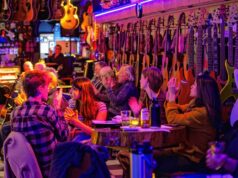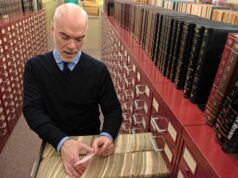
It’s a difficult conversation to bring up. It’s a public discourse that some have devoted a large portion of their lives trying to initiate in order to bring about societal change. It’s a conversation that is hundreds of years old. It’s about the 400-year history of slavery in the United States and making reparations for past damages toward African Americans.
As Juneteenth approached on June 19, Amilcar Shabazz recalled his own upbringing in Beaumont, Texas — the last state to concede in the Civil War and where the holiday commemorating the last freed slaves originated.
“Just 17 years before I was born, my family were victims of a race riot,” said Shabazz, an Amherst resident and a professor of history and Africana studies at the University of Massachusetts Amherst. The riot in Shabazz’s hometown of Beaumont was on a scale of the Tulsa Race Massacre, Shabazz said. The Tulsa Race Massacre occurred in 1921, when a white mob descended on the Black section of the Oklahoma city and burned more than 1,000 homes and destroyed a thriving business district known as “Black Wall Street.”
“My family members were burned out of homes, out of businesses, my own grandparents and their siblings,” Shabazz said in an interview with the Advocate. “I grew up with that kind of trauma within my own family from racism and racial injustice.”
In 1943, a race riot took place in Beaumont, a shipbuilding center, when hundreds of Black homes and businesses were damaged by about 4,000 rioters who were angry over the alleged rape of a white woman by a Black man. Over 200 people were arrested and 50 injured.
Discussing reparations for members of the Black community brings up a lot of painful history. Yet activists across the nation are attempting to have these difficult conversations to bring historical evidence to light in order to make the case for reparations for past racial injustices in the United States.
A congressional bill, commonly referred to as H.R. 40 (in reference to the failed government effort to provide 40 acres of land to newly freed slaves after the Civil War) was first introduced in 1989. The bill would create a commission to study reparations in the United States, and it passed the House Judiciary Committee this past April after languishing for over 30 years. Now it faces the steep challenge of passing a full House that has zero Republican support among its 176 co-sponsors, and which would need to hurdle over a sharply partisan Senate where it requires 60 votes.
Were the commission to be formed, there is plenty of widely available evidence of inequalities that continue to exist, which many point to as evidence of the lasting legacy of slavery.
In 2017, the Pew Research Center found that the median wealth of white households was 10 times larger than the median wealth of Black households, based on data from 2016. It also found that only 25 percent of white households are in the lower-income tier, compared with about 50 percent each of Black and Hispanic households.
Some local communities, such as Amherst, are not waiting for federal action to address these inequalities. Amherst joins other efforts across the country, including Evanston, Illinois, the state of California, and religious institutions, such as the Minnesota Council of Churches — all who benefited from the institution of slavery — and are now trying to amend for past injustices.
The Amherst Town Council is in the process of establishing a reparations fund that will be overseen by what is being called an African Heritage Reparations Assembly, a town entity made up of mostly Black residents.
In Franklin County, a small group of residents are taking a different route. The group Racial Justice Rising, an organization of social justice advocates, is creating a publicly-funded trust that will provide grants to Black residents and organizations.
In other communities, such as Northampton, conversations around reparations are in the early stages for community members that want to take action.
Questions on what constitute reparations swirl around the discussion: Who will receive it? How will they receive it? Who will pay? There is no one answer, and that is why many communities are starting the discussion in earnest in an attempt to right past wrongs.
Amherst’s historic vote
Last month, Amherst took a historic vote to create among the first municipally-run reparations funds in the country. The Town Council voted in favor of creating a special purpose fund for reparations, which will be overseen by the aforementioned African Heritage Reparations Assembly, a yet-to-be convened assembly whose members are not yet determined.
Amherst officials expect the account to start with $210,000 once the town’s free cash is certified later this year. The African Heritage Reparations Assembly will be tasked with determining a plan for distribution of reparation funds once the Black-majority group has members appointed later this year.
The effort to push the council to provide reparations for Black residents in town began last year when Michele Miller and Matthew Andrews, two white residents and business owners in Amherst, decided to take a stand against what they described as the town’s history of anti-Black discrimination and injustice.
They formed Reparations for Amherst, and the group launched a petition last summer which led to the council adopting a resolution last December. “This resolution [is] a first step in the reparative process and understands there is substantial work to be done,” it read.
Miller and Andrews embarked on a fact-finding mission about the town’s history of slavery and discrimination to accompany the petition-drive for the resolution to shed light on past and present-day inequalities. The petition collected over 400 signatures, and it put the council on “a path of remedy for Black Amherst residents who have been injured or harmed by discrimination and racial injustice,” according to the resolution.
“We have strived to lead with data from the very beginning,” Miller said. “We knew from the beginning that we needed to uncover any data available to use, and provide it to the public and town, to make it clear why we were initiating this effort.”
According to the group’s report about the history of slavery in Amherst, a government survey from 1754 to 1755 showed that a total of 18 Black “slaves … Sixteen Years Old and Upward” — “13 males” and “5 females” — were enslaved in Hadley/Amherst. This statistic is cited from “Slavery in the Connecticut Valley of Massachusetts,” (2009) by Amherst College Professor Emeritus Robert Romer.
The report also states that the daily lives of Black people in Amherst “consisted of performing the hard labor tasks that whites wanted to avoid. Black men worked in the field and the mills and on road repair crews. They filled mudholes in the highways, removed rocks, and dug ditches.” This passage was cited from “The History of the Black Population of Amherst, Massachusetts 1728-1870,” (1999) by James Avery Smith.
“We are in New England where slavery is not thought to be prevalent, and here we found many cases of slavery, and we didn’t uncover all of it,” Miller said.
A separate report on modern day inequities bolsters the case for reparations, Miller and Andrews claim.
In 2020, a report by the League of Women Voters found that Black family median income in Amherst in 2019 was $45,464, whereas white family median income was 2.4 times greater at $108,500.
“People want to say, that wasn’t me, I didn’t enslave people,” Miller said. “I think it’s wrong, so we direct people to current disparities as a way to understand why this (reparations) matters, and what the legacy (of slavery) is, and how its manifested in the present day.”
Action in Franklin County
In Franklin County, there is a grassroots effort underway to provide reparations to Black community members using a different approach than Amherst or Evanston.
Racial Justice Rising, a volunteer organization whose roots took hold in 2004, has a dedicated reparations group that meets twice a month to discuss and plan initiatives around making restitution to Black community members for historical harms.
The Reparations Committee of RJR formed last year with the goal of building public support for reparations and restorative justice for descendants and survivors of slavery, the genocide of Indigenous peoples, and other legacies and present-day crimes cause by racial oppression.
“A big piece of success of the meeting for me, and the effectiveness of the committee, is that we realize that as white people, we have a lot to learn,” Allen Davis, a member of the reparations committee and a Northampton resident, said in an interview. “We also want to act and take action.”
The reparations committee holds meetings twice a month, which for the past year have entirely been virtual due to the pandemic. The committee is made up of six members, all white, who are working on outreach efforts to bring in more people of color, according to organizers.
According to Davis, the committee is headed in three directions: educating the public about the history of reparations; developing a plan to create a collective reparations account; and creating an accountability committee, which will be composed by people of color to oversee the reparations process.
Davis, for his part, has published a historical timeline of reparations, from 1783 through 2021, by numerous United States entities, with the assistance of librarians at UMass Amherst Libraries.
“Most people think reparations is a new idea,” Davis said. “But reparations have been given to Indigenous people, Black Americans, and probably most well-known is in 1988 when reparations were given to descendants of Asian Americans who were interned in camps during World War II.”
As for the collective reparations account, Davis said the plan is to open it at the Greenfield Savings Bank, solicit donations from the public, and distribute funds to various organizations.
“We will, with the advice of people of color … make contributions to local, state, and national organizations led by people of color,” Davis said.
Inspired by an op-ed from a Georgetown sociology professor named Michael Eric Dyson which called for white allies to create individual reparations accounts, Davis said he has donated at least once a year to politicians or organizations led by people of color on his own.
The accountability committee “will both inform us on how to allocate the funds from the collective reparations account and to tell us how as a committee what we are doing and hold us accountable on our work as a reparations committee,” Davis said.
“We are slowly growing the group,” Davis said. “The only way to dramatically reduce the almost 10-to-1 wealth gap between Black and white households is for the federal government to create and fund a significant reparations program.”
Northampton in early stages
In Northampton, conversations about how to go about providing reparations are underway among members of the B’Nai Israel. Thomas Weiner, a sixth grade teacher, said he and other residents began expressing interest in taking a similar approach to the one they saw across the Connecticut River in Amherst.
They were interested in what communities such as Amherst and Evanston were doing in using marijuana tax revenues in order to create streams of funding for reparations to Black community members.
Weiner and Sara Weinberger began recruiting more members to their small group, all who were white and many from the synagogue, and eventually, Miller, Andrews and Shabazz were taking part in their discussions.
Originally, the group’s intention was to take a similar path to the one activists took in Amherst — meaning creating a petition for the City Council to take up a resolution, and form a municipal committee dedicated to finding ways to provide reparations.
Soon, it became clear that taking a step back and pausing the effort made the most sense. The reason being the group was formed entirely of white residents.
“This has enormous implications and ramifications for Black people,” Weiner said. “We said, wait a minute, there are just white people leading this reparations effort. We pressed pause and we were raising questions about trying to reach out to bring Black people into the group — a group that needed to not already be defined. They would be forming from the ground up, and forging with us. We decided to hold off on a petition and goals.”
The group is now working on outreach efforts to Black residents of Northampton to bring into the fold and build out a reparations plan from the ground up.
“We are meeting individually with people to see if they want to join or be part of a group seeking reparations from the city,” Weiner said.
Weiner said the group has pressed pause with the intention of resuming a petition strategy for the fall. The idea is to bring in more residents of color in the meantime. The group is reaching out to a range of people in different professional roles — teachers, lawyers, professors, and others, he said.
“We’ve attempted not to see Amherst as the blueprint,” Weiner explained. “We are trying to have Black people, if possible, really take an equal — if not more — leadership in the work, rather than the work being decided by white people.”
He added, “We are not sure if we can pull it off, but it’s a work in progress.”
There are different feelings on what reparations even means, Weiner noted. “That’s the process we are engaged with.”








